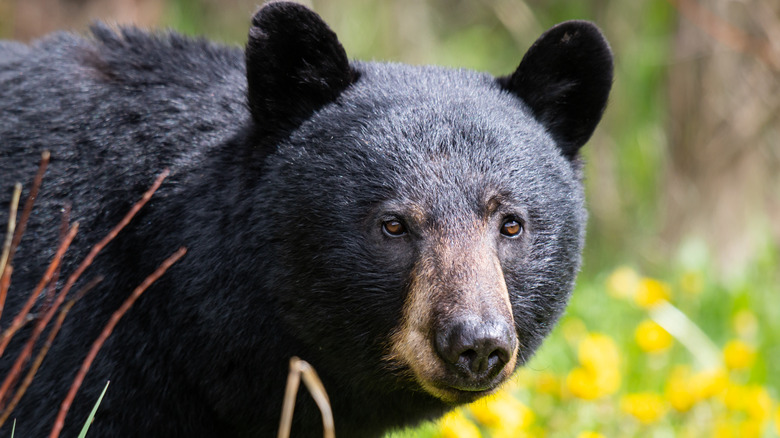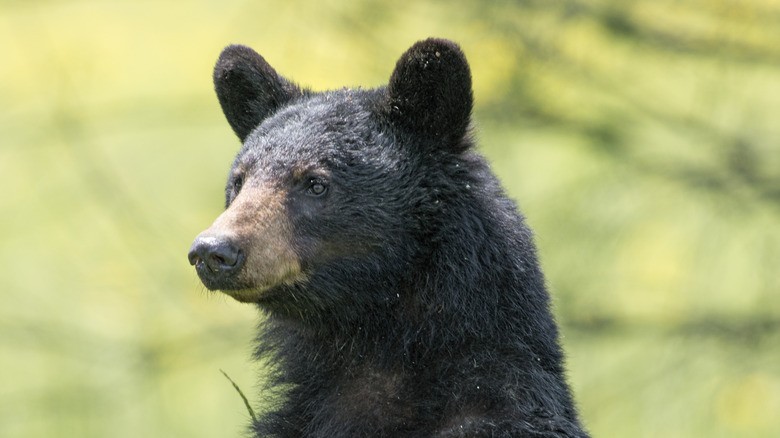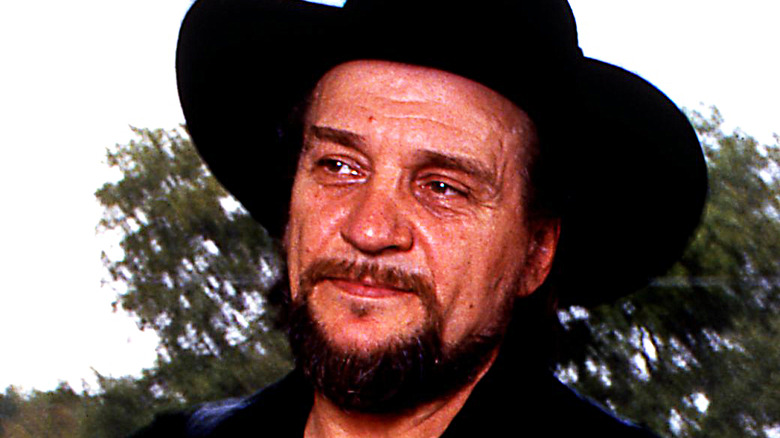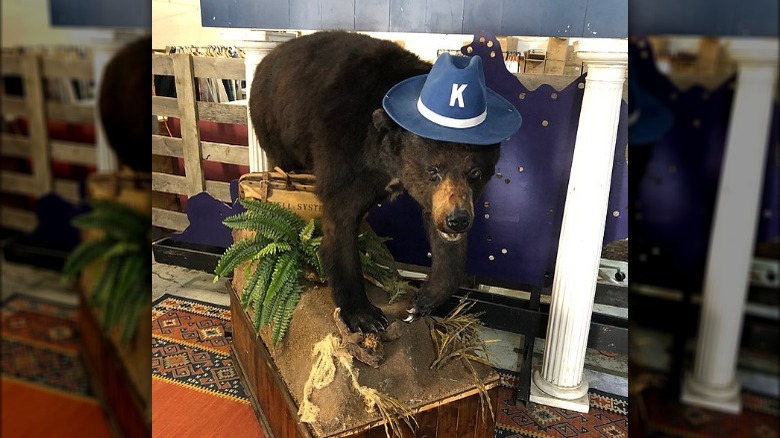Here's Where You Can See The Real 'Cocaine Bear' On Display
Ask yourself this: What's more terrifying than a bear, those primordial powerhouses of lethal strength and all things alpha energy? Well, a bear on cocaine is a good start, according to actress Elizabeth Banks. She directed the film, "Cocaine Bear," which is set to be released in February 2023 (via IMDB). Banks' movie, which she also co-produced, takes place in 1985, and it chronicles a story of a real-life black bear. In Banks' version of events, the bear goes on a killing spree after ingesting a colossal amount of cocaine the animal found in the Georgia wilderness. Banks calls the story a tribute to classic horror films and comedy (via CinemaBlend).
Also according to CinemaBlend, Banks said, "[T]he reason I made it was not necessarily because of the crazy bear ... I love horror and I love gore, and I love comedy ... So this is a real opportunity to create a homage to some of those kinds of films, but also to do something really unique." Though parts of Banks' movie are fictionalized (the killing spree never happened, per CNN), "Cocaine Bear," — starring Keri Russell and featuring the late actor Ray Liotta in his last film performance — is based on a true story. The mounted remains of the bear — cleverly nicknamed post-mortem 'Pablo EskoBear" — are on display to this day.
The cocaine bear true story
The true story of the real 'cocaine bear' begins with a drug-smuggling operation gone awry. According to CNN, an unsuspecting black bear was minding his own business in the Georgia wilderness when the creature happened upon 40 bags of the powdery stimulant. Sadly, they don't offer D.A.R.E. classes for animals, and the 175-pound animal learned about the dangers of drugs the hard way (via The New York Times). The black bear known today as 'Cocaine Bear' came upon a good amount of discarded cargo and likely in a state of curiosity and hunger, devoured all 40 bags. It's estimated the bear consumed $20 million in cocaine, or about $53 million in 2022 money (via Dollar Times).
Just prior to the bear's unlucky discovery, Andrew Thornton II, one of the drug smugglers, leaped from an airplane carrying 400 kilos of cocaine but fell to his death after his parachute failed to open. His body was later found in a south Knoxville, Tenn. backyard. According to a 1985 Associated Press (AP) report on the incident, Gary Garner of the Georgia Bureau of Investigation said the bear got to the cocaine before the authorities did. "[The bear] tore the duffel bag open, got him some cocaine and OD'd (overdosed) ... There's nothing left but bones and a big hide,″ Garner explained. Among other symptoms, signs of an overdose in the bear included heart and renal failure, stroke, and cerebral hemorrhaging, based on reporting from the Knoxville News Sentinel.
The two drug smugglers were on their way back from Colombia
Bill Leonard, Thornton's smuggling partner who actually survived his descent from the aircraft, told the Knoxville News Sentinel in 1990 that, when they bailed out, the pair were on their way home from Colombia, where they picked up the drugs a few days earlier. They decided to abandon their aerial post when they started to panic about a possible FBI pursuit. Before bailing out, the pair of drug smugglers threw large portions of their cocaine cargo from the plane. But believe it or not, the most riveting part of the bear's journey was far from over.
According to the Knoxville News Sentinel, the animal was examined by a Georgia legal team and then stuffed. For a time, Pablo was showcased in Georgia's Chattahoochee River National Recreation Area, but he went missing after an unknown thief stole him. He was later discovered in the home of none other than country music legend Waylon Jennings (pictured), an avid taxidermy collector. It's tough to say exactly what happened to Pablo after living with Jennings or how exactly he wound up on display at a Chinese medicine shop in Reno, Nevada, but after a painstaking search that stretched far and wide, the Kentucky-based retailer Kentucky for Kentucky tracked down the bear and purchased the stuffed carcass from the Nevada shop owners for $200 (via the Knoxville News Sentinel).
The bear is now on display in Kentucky
Regarding the "Cocaine Bear," the wife of the Reno-based medicine shop owner said (via Saving Country Music) that her husband was always bringing home junk from auctions and estate sales and that the bear was one of his favorite things. "He just loved it for some reason. At first, he wanted to keep it in our living room but I wouldn't have it. It scared me. I made him take it to the store," she said.
According to WBIR Channel 10, Pablo now spends his days on display in a Kentucky for Kentucky shop in Lexington, where the business also sells merchandise with a bear illustration on them captioned "Cocaine bear — the ultimate party animal." According to "Cocaine Bear" director Elizabeth Banks (via CinemaBlend), her difficult-to-believe cocaine bear movie was inspired by films like "Jaws" and "Jurassic Park." Per CinemaBlend, Banks said, "It would be cool to see a bear in nature. That would be fun. And, then also it could turn terrifying. Like if you weren't paying attention or if the bear did cocaine."
If you or anyone you know needs help with addiction issues, help is available. Visit the Substance Abuse and Mental Health Services Administration website or contact SAMHSA's National Helpline at 1-800-662-HELP (4357).



